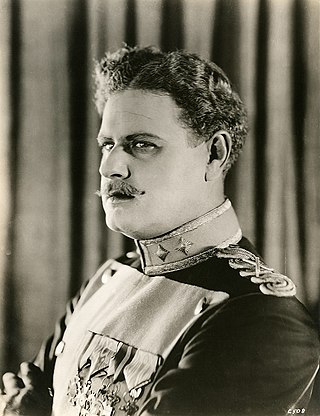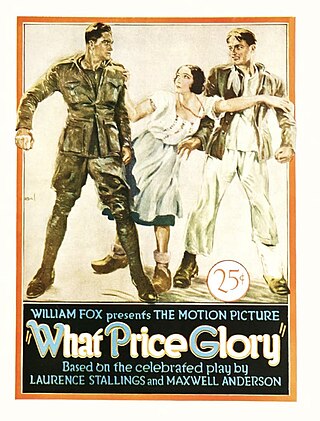Related Research Articles

Alan Hale Sr. was an American actor and director. He is best remembered for his many character roles, in particular as a frequent sidekick of Errol Flynn, as well as films supporting Lon Chaney, Wallace Beery, Douglas Fairbanks, James Cagney, Clark Gable, Cary Grant, Humphrey Bogart, and Ronald Reagan. Hale was usually billed as Alan Hale and his career in film lasted 40 years. His son, Alan Hale Jr., also became an actor and remains most famous for playing "the Skipper" on the television series Gilligan's Island.

James Patrick Hogan was an American filmmaker. The films Hogan directed include Bulldog Drummond's Secret Police (1939) and The Mad Ghoul (1943), his last film. He died from a heart attack aged 53.

Anna Quirentia Nilsson was a Swedish-American actress who achieved success in American silent movies.

What Price Glory? is a 1926 American synchronized sound comedy drama war film produced and distributed by Fox Film Corporation and directed by Raoul Walsh. The film was released with a synchronized musical score with sound effects using the Movietone sound system. The film is based on the 1924 play What Price Glory by Maxwell Anderson and Laurence Stallings and was remade in 1952 as What Price Glory starring James Cagney. Malcolm Stuart Boylan, founder of the U.S. Coast Guard Auxiliary, was title writer on the silent Fox attraction.
George Joseph Folsey, A.S.C., was an American cinematographer who worked on 162 films from 1919 to his retirement in 1976.

John J. Mescall, A.S.C. was an American cinematographer. He photographed such silent films as Ernst Lubitsch's The Student Prince in Old Heidelberg (1927), but he is best known for his work in the 1930s at Universal Pictures, where he often worked on the films of James Whale. Mescall was famous for his elaborate, some might say grandiose, effective camera movements, in which the camera would often track completely across or around a set, or even one performer. He did not always use these kinds of camera movements, but his most famous films all have them.

Film Booking Offices of America (FBO), registered as FBO Pictures Corp., was an American film studio of the silent era, a midsize producer and distributor of mostly low-budget films. The business began in 1918 as Robertson-Cole, an Anglo-American import-export company. Robertson-Cole began distributing films in the United States that December and opened a Los Angeles production facility in 1920. Late that year, R-C entered into a working relationship with East Coast financier Joseph P. Kennedy. A business reorganization in 1922 led to its assumption of the FBO name, first for all its distribution operations and ultimately for its own productions as well. Through Kennedy, the studio contracted with Western leading man Fred Thomson, who grew by 1925 into one of Hollywood's most popular stars. Thomson was just one of several silent screen cowboys with whom FBO became identified.

Emily Fitzroy was an English theatre and film actress who eventually became an American citizen. She was at one time a leading lady in London for Sir Charles Wyndham.

Katherine Duffy, known professionally as Kate Price, was an Irish-American actress. She is known for playing the role of Mrs. Kelly in the comedy series The Cohens and Kellys, made by Universal Pictures between 1926 and 1932. Price appeared in 296 movies from 1910 to 1937.

Eldon Raymond McKee, also credited as Roy McKee, was an American stage and screen actor. His film debut was in the 1912 production The Lovers' Signal. Over the next 23 years, he performed in no less than 172 additional films.

Gaston Glass was a French-American actor and film producer. He was the father of the composer Paul Glass.

Tiffany Pictures, which also became Tiffany-Stahl Productions for a time, was a Hollywood motion picture studio in operation from 1921 until 1932. It is considered a Poverty Row studio, whose films had lower budgets, lesser-known stars, and overall lower production values than major studios.
Sinclair Hill was a British film director, producer and screenwriter. He directed nearly fifty films between 1920 and 1939. He was born as George Sinclair-Hill in London in 1894. He was awarded an OBE for his services to film.

Templar Saxe was a British-born stage actor, opera singer and silent film actor. In films, he usually was a character actor as his singing voice could not be used in silent films. He was born in Redhill, Surrey, England and died in Cincinnati, Ohio.
Barney McGill was an American cinematographer who was nominated at the 4th Academy Awards for Best Cinematography for the film Svengali. He was born in Salt Lake City, Utah in 1890. He was the cinematographer for more than 90 films from 1919 to 1941.

Freeman Wood was an American character actor of the silent and sound film eras.

The Lady of the Harem is a 1926 American silent adventure film directed by Raoul Walsh and written by James Elroy Flecker and James T. O'Donohoe. The film stars Ernest Torrence, William Collier Jr., Greta Nissen, Louise Fazenda, George Beranger, Sôjin Kamiyama, and Frank Leigh. The film was released on November 1, 1926, by Paramount Pictures. It also had the alternative title The Golden Voyage.

Edward Cecil was an American film actor. During the silent era he played supporting roles and the occasion lead. Following the introduction of sound, he mainly appeared in more minor roles until his death.

Charles A. Logue was an American screenwriter and occasional film director active in the silent and early sound era.
Chester A. Lyons (1885–1936) was an American cinematographer. Active in the American film industry from 1917 until his death he worked on over eighty films during his career, the majority of them in the silent era. He began his career with Triangle Films and was later employed by Paramount, Fox, First National and MGM.
References
- ↑ "AFI|Catalog". catalog.afi.com. Retrieved 2023-02-11.